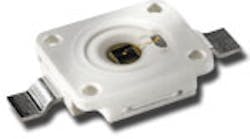Optical And Display Technologies Forge Ahead Through A Tough Year
In 2009, a year riddled and rattled with gloomand- doom financial forecasts, there was no slowdown in the quantity of new products in the tech market. In terms of quality, there was no shortage of innovation either, particularly in the optical arena.
OPTICAL ADVANCES BOOST VIEWING
Back in October, Avago Technologies unveiled an embedded optical engine technology that will enable high-speed connectivity in a wide range of electronic computing and consumer applications (Fig. 1). In essence, the technology forecasts higher-speed interconnects than what is currently available.
The first adopter of the company’s embedded optical engine technology is Intel. Employing the engine, its Light Peak optical fiber cable technology for running multiple existing I/O protocols on a single cable delivers a bandwidth starting at 10 Gbits/s with the potential to scale to 100 Gbits/s over the next decade.
At 10 Gbits/s, users can transfer a full-length Bluray movie in less than 30 s. Furthermore, Avago’s optical engine features a 2-mm profile and consumes 135 mW per 10G channel.
Also in October, 3M Electronics released a unique 3D optical film for enhancing handheld displays. In application, this 3D field sequential optical film reportedly enables true auto stereoscopic viewing without the need for special glasses (Fig. 2).
Rather than being applied to the LCD screen, the film easily integrates into the backlight module and only requires a single LCD panel operating at a 120- Hz refresh rate. Backlight module assembly is nearly identical to that of existing systems, allowing for simpler integration during the assembly stage.
The standard optical film stack is then replaced with a reflective film, custom light guide, and 3M’s 3D film. Using directional backlight technology, the left and right images are focused sequentially into the viewer’s eyes, enabling a full-resolution display of the panel.
LED DOUBLES POWER, OLEDS GET SKINNY
October was also a very busy month for Osram Opto Semiconductors, which substantially boosted the power of its established IR Platinum Stack Dragon LED module. In a 1-mm ThinFilm chip-in-stack package, the component now delivers an output power of nearly 1 W with a drive current of 1 A, almost twice the output of the company’s standard chips (Fig. 3).
The significant power increase is attributable to the ThinFilm chip, which exploits two p-n junctions that are grown or stacked on top of each other. Apparently, this stacking technique achieves almost twice the optical output power of conventional IR ThinFilm chips. The package’s viewing angle and radiant intensity are variable using standard secondary optics as well.
Osram also developed a super-low-profile organic LED (OLED) as part of a research project funded by the German Ministry for Education and Research, again in October. The result of a unique technology, Osram unveiled OLED prototypes that are just a few hundred micrometers thick and do not require separate encapsulation. Revealing their viability as light sources in a plethora of applications, the transparent test samples exhibit a luminous area of 210 cm.
According to the company, the 17- by 17-cm OLED panels provide a clear indication that the OLED lighting market is shifting toward low-profile transparent light sources (Fig. 4). The project, which will run through 2011, is expected to produce 1-m large transparent OLED modules. As of now, though very slim in the ballpark of 300 to 700 µm, the viewable size of the modules needs to increase. Future development will focus on an even thinner carrier material.
The thin OLED panels can be made transparent without any detracting structures, i.e., without any additional conductor path structures on the light-emitting surface. This will allow even distribution of current over the active surface, ensuring uniform luminance. The OLED technology also could simplify manufacturing processes. It’s useable for colored, warm, or cold white OLEDs regardless of the material of the active layers.
TOUCH SENSORS FOR GESTURING
Debuting in July, Synaptics’ multi-touch ClearPad 3000 series capacitive touch sensors enable designers to integrate highresolution capacitive touchscreens with basic gesture capabilities into a wide variety of mobile and handheld devices (Fig. 5). Paired with the company’s lower-end touch sensors, the Enhanced Gesture Suite gives users a range of touch-and-gesture capabilities from single-finger touch with simple gestures to multi-finger touch with complex gestures.
The sensors can distinguish up to 10 simultaneous finger touches and complex multi-finger gestures, i.e., pinch, pivot rotate, and rotate, with fine accuracy and low latency. Their proprietary technology relies on 48 sensing channels and advanced power management, allowing for screen sizes up to 8 in. diagonally. Almost borderless with a high immunity noise, the 0.4-mm thick components specify an accuracy of ±1 mm and a power consumption of 5 mA in active mode, 150 µA nominal, and 12 µA in deep sleep mode.
